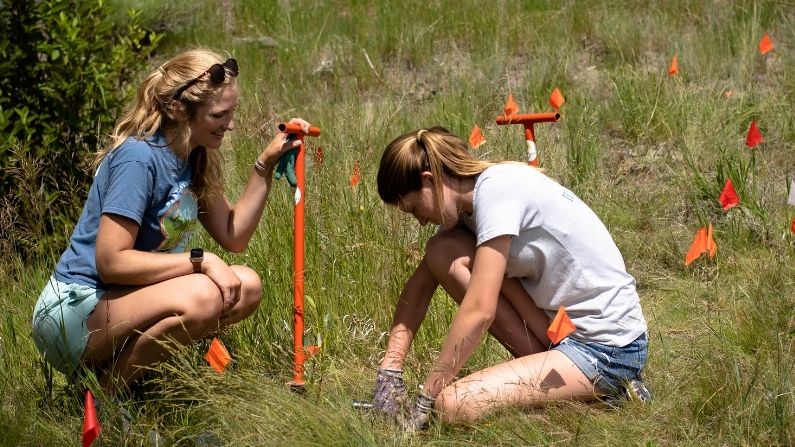Volunteers with the Teton Botanical Garden are working to restore 20 acres of habitat that burned in a 2019 fire behind the National Museum of Wildlife Art, on the outskirts of Jackson. The initiative is part of a new garden that aims to educate museum visitors about the habitat and ecology of the Greater Yellowstone Ecosystem. Botanist Trevor Bloom guided KHOL through the new installation that begins just behind the restaurant Palate and extends for about a quarter mile along the existing sculpture trail.
“You go from Palate, which is a wildflower meadow, through an Aspen grove, into a sagebrush steppe into another Aspen grove by the Herb Alpert statues, along another sagebrush steppe and wildflower meadow area into another Aspen grove,” Bloom said. “And then the pollinator garden is all the way at the north end of the sculpture trail, where there’s a wolf and a wild rosebush, and the pollinator garden kind of symbolically then extends into the natural zone.”
The garden reflects the natural habitats found in Teton County — habitats that change based on elevation and water availability. Rayleen McCalman of the nonprofit Teton Botanical Garden said that this design is intentional.
“So, down here at the elk refuge, there’s a riparian area. There’s a lot of water, it’s mainly grasslands and with the meandering stream through here. But as soon as you cross the highway, there’s no water. And so what you see is the sagebrush steppe,” McCalman said. “This is more natural for the arid areas of Wyoming where there isn’t as much water. But where we happen to be standing right here, which is right next to an Aspen grove, this is an artificial installation right here but it does mimic what we would see at a higher elevation — cooler temperatures with more water.”
The garden is partly a study area — a way for scientists to learn more about post-fire restoration. It’s also a way to demonstrate the benefits of native plants, and in a hotter and drier world, that’s a good thing, according to McCalman.
“There is an assumption that native wild plants can take care of themselves. And the important thing to note is that they do require a little bit of care in the beginning, which is why we’re dependent upon the irrigation. But once they’re established, they actually take much less care than a manicured landscape,” McCalman said. “They take less water, they take less weeding. You’re just not putting in the same number of inputs into a native plant landscape as you would one of the more manicured lawns and mulched gardens.”
The museum plans to debut an installation with interpretive signs, as well as an audio tour in both English and Spanish next spring. Until then, there are volunteer planting days scheduled throughout the remainder of October. To get involved before the long Teton winter sets in, contact Trevor Bloom at trevor.bloom@tnc.org.






